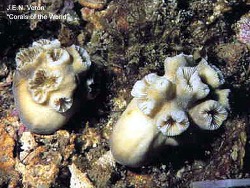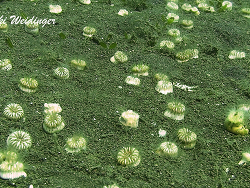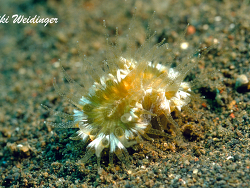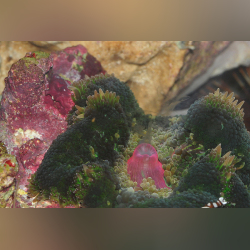Info
Heteropsammia cochlea (Spengler, 1781)
This small solitary coral with a diameter of no more than 2.5 cm is not attached to the seabed. It consists of one or two corallites in the shape of a figure eight when viewed from above, making it easy to identify. The base in contact with the bottom is relatively circular, either flat or slightly keeled depending on the nature of the substrate. The overall color is yellowish, grayish, or greenish. The polyp tentacles open at night.
The base has an opening that houses a commensal worm that belongs to the Aspidosiphonidae family. The overall color is yellowish, grayish, or greenish. The polyp tentacles can be seen unfolded especially at night.
This coral attaches itself as a larva to a snail shell and overgrows it over time. In doing so, it forms a commensal association with a splash worm (Aspidosiphon (Aspidosiphon) muelleri muelleri Diesing, 1851) that lives on the underside of the coral (or in the snail shell). To survive in its biotope, and especially to avoid being buried, this small coral has an obligate commensal relationship with a small splash worm housed under the base of the coral. The worm's movements in search of food prevent the coral from being buried. However, the coral is dependent on the worm staying nearby. The small coral often has a small parasitic mollusk, Leiosolenus lessepsianus, as another subtenant.
The wandering coral is a common species in its range. It can reproduce both sexually by gamete release or asexually by budding a new individual from the "parent" body. There is no obvious sexual dimorphism between male and female corals.
This worm prevents the coral from sinking into the soft sediment and also from moving on it. It is believed to be a zooxanthellate coral, meaning it lives on light.
In 2022, the hermit crab, Diogenes heteropsammicola Igawa & Kato, 2017, was reported in the journal Ploss to have replaced the splash worm usually found in coral, and to live in coral.
https://journals.plos.org/plosone/article?id=10.1371/journal.pone.0184311
Synonymised names:
Heteropsammia aphrodes Alcock, 1893 · unaccepted > junior subjective synonym
Heteropsammia cochlea alta Yabe & Eguchi, 1932 † · unaccepted > junior subjective synonym
Heteropsammia cochlea var. alta Yabe & Eguchi, 1932 † · unaccepted > junior subjective synonym
Heteropsammia michelinii Milne Edwards & Haime, 1848 · unaccepted > junior subjective synonym
Heteropsammia michelinii var. formosus Hu, 1987 † · unaccepted > junior subjective synonym
Heteropsammia ovalis Semper, 1872 † · unaccepted > junior subjective synonym
Heteropsammia ovalis formosensis Yabe & Eguchi, 1942 † · unaccepted > junior subjective synonym
Heteropsammia ovalis japonica Yabe & Eguchi, 1942 † · unaccepted > junior subjective synonym
Heteropsammia ovalis var. formosensis Yabe & Eguchi, 1932 † · unaccepted > junior subjective synonym
Heteropsammia pisum Alcock, 1902 · unaccepted > junior subjective synonym
Heteropsammia rotundata Semper, 1872 · unaccepted > junior subjective synonym
Madrepora cochlea Spengler, 1781 · unaccepted > superseded combination (basionym)
Psammoseris cylicioides Tenison-Woods, 1879 · unaccepted > junior subjective synonym
This small solitary coral with a diameter of no more than 2.5 cm is not attached to the seabed. It consists of one or two corallites in the shape of a figure eight when viewed from above, making it easy to identify. The base in contact with the bottom is relatively circular, either flat or slightly keeled depending on the nature of the substrate. The overall color is yellowish, grayish, or greenish. The polyp tentacles open at night.
The base has an opening that houses a commensal worm that belongs to the Aspidosiphonidae family. The overall color is yellowish, grayish, or greenish. The polyp tentacles can be seen unfolded especially at night.
This coral attaches itself as a larva to a snail shell and overgrows it over time. In doing so, it forms a commensal association with a splash worm (Aspidosiphon (Aspidosiphon) muelleri muelleri Diesing, 1851) that lives on the underside of the coral (or in the snail shell). To survive in its biotope, and especially to avoid being buried, this small coral has an obligate commensal relationship with a small splash worm housed under the base of the coral. The worm's movements in search of food prevent the coral from being buried. However, the coral is dependent on the worm staying nearby. The small coral often has a small parasitic mollusk, Leiosolenus lessepsianus, as another subtenant.
The wandering coral is a common species in its range. It can reproduce both sexually by gamete release or asexually by budding a new individual from the "parent" body. There is no obvious sexual dimorphism between male and female corals.
This worm prevents the coral from sinking into the soft sediment and also from moving on it. It is believed to be a zooxanthellate coral, meaning it lives on light.
In 2022, the hermit crab, Diogenes heteropsammicola Igawa & Kato, 2017, was reported in the journal Ploss to have replaced the splash worm usually found in coral, and to live in coral.
https://journals.plos.org/plosone/article?id=10.1371/journal.pone.0184311
Synonymised names:
Heteropsammia aphrodes Alcock, 1893 · unaccepted > junior subjective synonym
Heteropsammia cochlea alta Yabe & Eguchi, 1932 † · unaccepted > junior subjective synonym
Heteropsammia cochlea var. alta Yabe & Eguchi, 1932 † · unaccepted > junior subjective synonym
Heteropsammia michelinii Milne Edwards & Haime, 1848 · unaccepted > junior subjective synonym
Heteropsammia michelinii var. formosus Hu, 1987 † · unaccepted > junior subjective synonym
Heteropsammia ovalis Semper, 1872 † · unaccepted > junior subjective synonym
Heteropsammia ovalis formosensis Yabe & Eguchi, 1942 † · unaccepted > junior subjective synonym
Heteropsammia ovalis japonica Yabe & Eguchi, 1942 † · unaccepted > junior subjective synonym
Heteropsammia ovalis var. formosensis Yabe & Eguchi, 1932 † · unaccepted > junior subjective synonym
Heteropsammia pisum Alcock, 1902 · unaccepted > junior subjective synonym
Heteropsammia rotundata Semper, 1872 · unaccepted > junior subjective synonym
Madrepora cochlea Spengler, 1781 · unaccepted > superseded combination (basionym)
Psammoseris cylicioides Tenison-Woods, 1879 · unaccepted > junior subjective synonym







 NikiWei
NikiWei
















